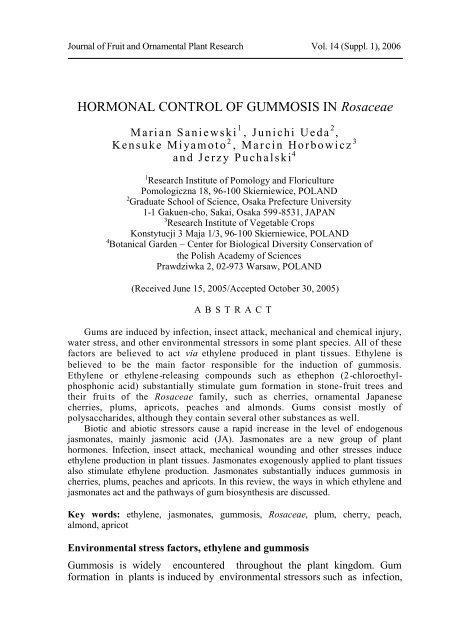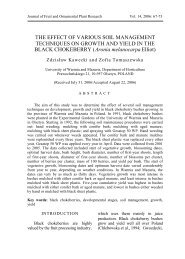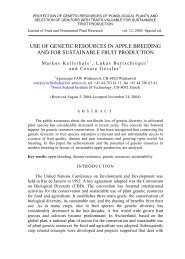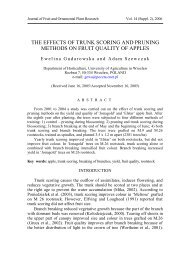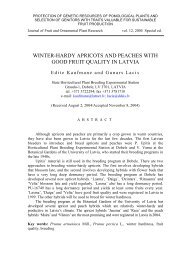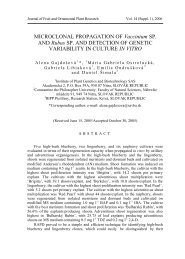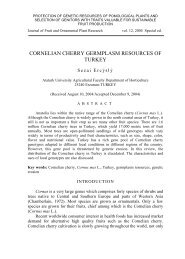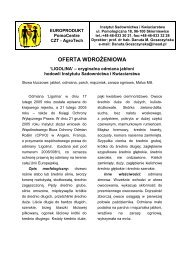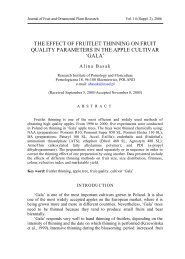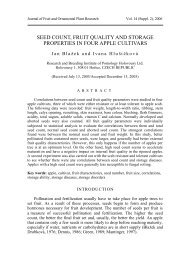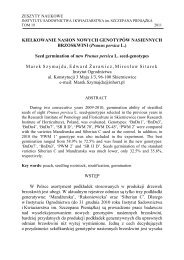HORMONAL CONTROL OF GUMMOSIS IN Rosaceae
HORMONAL CONTROL OF GUMMOSIS IN Rosaceae
HORMONAL CONTROL OF GUMMOSIS IN Rosaceae
You also want an ePaper? Increase the reach of your titles
YUMPU automatically turns print PDFs into web optimized ePapers that Google loves.
Journal of Fruit and Ornamental Plant Research Vol. 14 (Suppl. 1), 2006<strong>HORMONAL</strong> <strong>CONTROL</strong> <strong>OF</strong> <strong>GUMMOSIS</strong> <strong>IN</strong> <strong>Rosaceae</strong>M a ri a n S a ni e ws ki 1 , J u ni c hi U e da 2 ,K e n suke M i ya m o t o 2 , M a r ci n Ho r bowi cz 3a n d J e rz y P u ch a lski 41 Research Institute of Pomology and FloriculturePomologiczna 18, 96-100 Skierniewice, POLAND2 Graduate School of Science, Osaka Prefecture University1-1 Gakuen-cho, Sakai, Osaka 599-8531, JAPAN3 Research Institute of Vegetable CropsKonstytucji 3 Maja 1/3, 96-100 Skierniewice, POLAND4 Botanical Garden – Center for Biological Diversity Conservation ofthe Polish Academy of SciencesPrawdziwka 2, 02-973 Warsaw, POLAND(Received June 15, 2005/Accepted October 30, 2005)A B S T R A C TGums are induced by infection, insect attack, mechanical and chemical injury,water stress, and other environmental stressors in some plant species. All of thesefactors are believed to act via ethylene produced in plant tissues. Ethylene isbelieved to be the main factor responsible for the induction of gummosis.Ethylene or ethylene-releasing compounds such as ethephon (2-chloroethylphosphonicacid) substantially stimulate gum formation in stone-fruit trees andtheir fruits of the <strong>Rosaceae</strong> family, such as cherries, ornamental Japanesecherries, plums, apricots, peaches and almonds. Gums consist mostly ofpolysaccharides, although they contain several other substances as well.Biotic and abiotic stressors cause a rapid increase in the level of endogenousjasmonates, mainly jasmonic acid (JA). Jasmonates are a new group of planthormones. Infection, insect attack, mechanical wounding and other stresses induceethylene production in plant tissues. Jasmonates exogenously applied to plant tissuesalso stimulate ethylene production. Jasmonates substantially induces gummosis incherries, plums, peaches and apricots. In this review, the ways in which ethylene andjasmonates act and the pathways of gum biosynthesis are discussed.Key words: ethylene, jasmonates, gummosis, <strong>Rosaceae</strong>, plum, cherry, peach,almond, apricotEnvironmental stress factors, ethylene and gummosisGummosis is widely encountered throughout the plant kingdom. Gumformation in plants is induced by environmental stressors such as infection,
M. Saniewski et al.insect attack, flooding, and mechanical or chemical injury. All of the factorswhich stimulate gum exudation also promote ethylene production in planttissues (Boothby, 1983). Ethylene or ethylene-releasing compounds such asethephon (2-chloroethylphosphonic acid) stimulate gum formation in treesand fruits of stone-fruit species of the <strong>Rosaceae</strong> family, such as:●apricots (Prunus armeniaca L.) (Bradley et al., 1969);●Japanese apricots (Prunus mume Sieb. et Zucc.) (Li et al., 1995);●cherries (Prunus cerasus L.) (Olien and Bukovac, 1982ab);●ornamental Japanese cherries (Prunus yedoensis) (Ueda et al., 2003);●peaches (Prunus persica Batsch.) (Buchanan and Biggs, 1969; Li et al.,1995);●plums (Prunus domestica L.) (Bukovac et al., 1969); and●almonds (Prunus amygdalus Batsch.) (Ryugo and Labavitch, 1978).Based on these studies, ethylene is believed to be the main factorresponsible for the induction of gummosis.In peaches and Japanese apricots, gummosis can be caused byBotryosphaeria dothidea and Lasiodiplodia theobromae (syn. Botryodiplodiatheobromae) (Li et al., 1995; Beckman, 2003; Okie and Reilly, 1983). Inapricot shoots, gum formation can be caused by the Monilia laxa, M.fructigena, Cytospora cincta, or by larvae of Grapholita molesta (Rosik et al.,1971, 1975). In plum and cherry trees, gummosis can be caused by thebacterium Pseudomonas syringae or the fungus Stereum purpureum(Boothby, 1983). When a solution of naphthalene acetic acid (NAA) isapplied to peach trees, it inhibits sprout formation well, but causes severegummosis around the treated areas (Couvillon et al., 1977).The rate of ethylene production in vegetative tissue is correlated with theinternal level of the free auxin. Regulation of auxin-induced ethylenebiosynthesis has been found in mungbean and pea seedlings. Indole-3-aceticacid (IAA) stimulates ethylene production by inducing synthesis of 1-aminocyclopropane-1-carboxylic acid (ACC) from S-adenosylmethionine(SAM) (Yang and Hoffman, 1984). Gummosis induced by NAA in peachtrunks is probably associated with ethylene production. IAA and NAAsubstantially stimulate ethylene production in tulip stems (Saniewski et al.,2003 b).Gums are complexes of different substances, mostly polysaccharides ofdiverse structure. The composition of gum polysaccharides varies fromspecies to species and from cultivar to cultivar (Boothby, 1983; Saniewski etal., 2002, 2004ab).Gummosis of fungal origin significantly reduces tree growth and fruityield in susceptible peach cultivars (Beckman, 2003). This kind of gummosisis difficult to control with fungicides (Beckman, 2003; Li et al., 1995).Breeding cultivars resistant to pathogens and insects may be the only effectiveway to limit or eliminate gummosis.138J. Fruit Ornam. Plant Res. vol. 14 (Suppl. 1), 2006: 137-144
Gum duct formationHormonal control of gummosis in <strong>Rosaceae</strong>Gum ducts have been found in both woody tissues and fruits in allcultivated Prunus species. Gum ducts form naturally in healthy fruit trees.However, gum production intensifies after treatment with ethylene or ethylenereleasing compounds, infection, insect attack, mechanical damage, andenvironmental stress (Morrison and Polito, 1985).Gum duct formation is one of the processes involved in cell walldecomposition. This means that it is associated with living tissue. In cherryshoots, the beginning of gum duct formation can usually be seen in the nonlignifiedtissue formed by the cambium during lateral growth. The cells fromwhich form the gum ducts are called the initial cells. They can be identified bytheir dense cytoplasm and by the more intense staining of their cell walls with theperiodic acid-Schiff’s (PAS) reaction for carbohydrates. The dissolution of cellsstarts in the center of the initial cells. Gum ducts of different sizes finally form inthe wood. After the gum ducts form, the cambium remains active, and the ductsfinally become enclosed in the wood (Stösser, 1979).In almond fruits, the first sign of gum duct initiation is the differentiation ofdensely cytoplasmic secretory cells of the mesocarpal vascular parenchyma(Morrison and Polito, 1985). These secretory cells contain abundant dictyosomes,dictyosomal vesicles, mitochondria, and rough endoplasmic reticulum. Ductformation starts with the schizogenous separation of parallel rows of secretorycells. Later, the cytoplasm of the secretory cells degenerates as gum accumulatesin the space between the plasmalemma and the cell wall. Finally, the cell wallsand remaining cytoplasm disintegrate. Gum is primarily a secretory product ofspecialized secretory cells, but decomposed cell walls also appear to beincorporated into the gum during the lysigenous stage of duct development(Morrison and Polito, 1985). In intact almond fruits, there was a transient increasein ethylene production during gum duct initiation. Treatment with ethylenepromoted gum duct formation (Morrison et al., 1987a).In almonds, cell wall-degrading enzymes extracted from the free space ofthe cell wall are active during gum duct formation (Morrison et al., 1987b).Polygalacturonase and 1,3-β-glucanase activity rapidly increased during orright before the early schizogenous stage of duct initiation. α-galactosidase, β-galactosidase, α-arabinosidase and α-mannosidase were active during laterlysigenous stage of duct formation.Jasmonates and gummosisJasmonic acid (JA), methyl jasmonate (JA-Me) and related compoundsare widely distributed throughout the plant kingdom. They show variousbiological activities in regulating plant growth and development. Thesecompounds are called jasmonates, a new group of plant hormones (Ueda andKato, 1980; Saniewski, 1995; Creelman and Mullet, 1997; Koiwa et al., 1997;Murofushi et al., 1999).J. Fruit Ornam. Plant Res. vol. 14 (Suppl. 1), 2006: 137-144 139
M. Saniewski et al.Jasmonates promote gum production in tulip bulbs and stone-fruit treesand their fruits (Saniewski et al., 2000). JA-Me induced gum formation inplum shoots and fruits, peach shoots, cherry shoots and apricot shoots(Saniewski et al., 1998; 2003a; 2004ab). Endogenous jasmonates rapidlyincrease in plant tissues in response to infection, insect attack, mechanicaldamage, osmotic stress and other abiotic stressors (Saniewski, 1997). Stressinduces ethylene production in plants. Jasmonates increase ethylenebiosynthesis in intact plants and their organs by stimulating ACC synthaseand ACC oxidase activity (Saniewski, 1995; 1997; Saniewski et al., 1995).Exogenously applied JA-Me substantially increases ethylene production inpre-climacteric apples and in tomatoes at different stages of ripening(Saniewski, 1995).How jasmonates control ethylene biosynthesis in stressed tissues is not yetfully understood. In the plants described above, JA-Me seems work by thesame mechanism as ethephon (Saniewski et al., 2004ab).Interaction of ethylene and jasmonates in induction of gummosisApplying JA-Me and ethephon at the same time enhances gum productionin cherry, plum, apricot and peach shoots far more than applying either JA-Meor ethephon alone. Endogenous jasmonates and exogenously applied ethyleneact synergistically in gum formation. The reverse situation is also possible.The level of endogenous ethylene may be high enough to induce gumformation with exogenously applied JA-Me. Another possibility is thatethylene was able to induce gum formation without an increase in ethyleneconcentration because the process had already been triggered by JA-Me.When ethylene binds to its receptor on the plasma membrane, it might sensitizeJA-Me membrane receptors (Xu et al., 1994). In this case, ethylene and JA-Me mayco-regulate osmotin gene expression. JA-Me and ethylene synergistically causedthe breakdown of cell membranes and cell disintegration (Emery and Reid, 1996).This might be the reason for the induction of gum formation. Ethylene interactswith jasmonates in gummosis and other physiological processes (Saniewski et al.,1999). When JA-Me alone is applied ornamental Japanese cherry shoots, it does notinduce gum formation. This is probably because the level of endogenous ethylene istoo low to induce gummosis (Ueda et al., 2003). When inhibitors of cell wallpolysaccharides biosynthesis such as monensin and 2,6-dichlorobenzonitrile areapplied together with ethephon or JA-Me, they do not inhibit gum production(Saniewski et al., 2004b). Gummosis is therefore probably independent of the sugarmetabolism involved in the biosynthesis of cell wall polysaccharides. Whenethephon is applied together with inhibitors of jasmonates biosynthesis such asdiethyldithiocarbamate, salicylic acid, acetylsalicylic acid, indomethacin, ibuprofen,phenidone, or monophenylbutazone, it inhibits gum production in plum fruits.On the other hand, when inhibitors of ethylene biosynthesis such assalicylic acid, acetylsalicylic acid, aminooxyacetic acid and CoCl 2 are appliedtogether with JA-Me, they do not limit gum formation. This is difficult to140J. Fruit Ornam. Plant Res. vol. 14 (Suppl. 1), 2006: 137-144
Hormonal control of gummosis in <strong>Rosaceae</strong>explain, though it is possible that these inhibitors are only partially effectivein inhibiting ethylene production.The gums induced by ethephon, JA-Me, or both together have a similarpolysaccharide composition. Ethephon and JA-Me therefore probably inducegummosis by the same or a very similar mechanism (Saniewski et al., 2002,2004ab). The induction and production of gums is regulated by a signalnetwork of jasmonates and ethylene, especially by cross-signals betweenthem. Further research is needed to elucidate the physiological roles ofethylene and jasmonates in gum induction and formation.The physiological role of gums in plants is not yet clearly understood.Gums may play a role in inhibiting the spread of bacterial and fungalpathogens within infected tissues and from infected tissues to healthy ones.Gummosis in stone-fruit trees and their fruits is strictly connected with plantdefense system against infection and insect attack. Gummosis reduces treegrowth and fruit yield, especially in susceptible cultivars of stone-fruitspecies. Breeding cultivars resistant to pathogens and insects may be the onlyeffective way to limit or eliminate gummosis.REFERENCESBeckman T.G. 2003. Impact of fungal gummosis on peach trees. HORTSCIENCE 38:1141-1143.Boothby D. 1983. Gummosis of stone-fruit trees and their fruits. J. SCI. FOODAGRIC. 34: 1-7.Bradley M.V., Marei N., Crane J.C. 1969. Morphological and histological effects ofethrel on the apricot, Prunus armeniaca L. as compared with those of 2,4,5-trichloro- phenoxyacetic acid. J. AMER. SOC. HORT. SCI. 94: 316-318.Buchanan D.W., Biggs R.H. 1969. Peach fruit abscission and pollen germination asinfluenced by ethylene and 2-chloroethane phosphonic acid. J. AMER. SOC.HORT. SCI. 94: 316-318.Bukovac M.J., Zuicconi F., Larson R.P., Kesner C.D. 1969. Chemical promotion offruit abscission in cherries and plums with special reference to 2-chloroethylphosphonic acid. J. AMER. SOC. HORT. SCI. 94: 226-230.Couvillon G.A., Bass S., Joslin B.W., Odom R.E., Roberson J.E., Sheppard D.,Tanner R. 1977. NAA-induced sprout control and gummosis in peach.HORTSCIENCE 12: 123-124.Creelman R.A., Mullet J.E. 1997. Biosynthesis and action of jasmonates in plants.ANNU. REV. PLANT PHYSIOL. PLANT MOL. BIOL. 48: 355-381.Emery R.J.N., Reid D.M. 1996. Methyl jasmonate effects on ethylene synthesis andorgan-specific senescence in Helianthus annuus seedlings. PLANT GROWTHREGUL. 18: 213-222.Koiwa H., Bressan R.A., Hasegawa P.M. 1997. Regulation of protease inhibitors andplant defense. TRENDS PLANT SCI. 2: 379-384.Li H.-Y., Cao R.-B., Mu Y.T. 1995. In vitro inhibition of Botryosphaeria dothideaand Lasiodiplodia theobromae, and chemical control of gummosis disease ofJ. Fruit Ornam. Plant Res. vol. 14 (Suppl. 1), 2006: 137-144 141
M. Saniewski et al.Japanese apricot and peach trees in Zhejiang Province, China. CROP PROT. 14:187-191.Morrison J.C., Greve L.C., Labavitch J.M. 1987a. The role of cell wall-degradingenzymes in the formation of gum ducts in almond fruit. J. AMER. SOC. HORT.SCI. 112: 367-372.Morrison J.C., Labavitch J.M., Greve L.C.V. 1987b. The role of ethylene in initiatinggum duct formation in almond fruit. J. AMER. SOC. HORT. SCI. 112: 364-367.Morrison J.C., Polito V.S. 1985. Gum duct development in almond fruit, Prunusdulcis (Mill.). D.A. Webb. BOT. GAZ. 146: 15-25.Murofushi N., Yamane H., Sakagami Y., Imaseki H., Kamiya Y., Iwamura H., HiraiN., Tsuji H., Yokota T., Ueda J. 1999. Plant Hormones. In: ComprehensiveNatural Products Chemistry (Editor Miscellaneous Natural Products includingMarine-in Chief: Sir Derek Barton, Koji Nakanishi, Executive Editor: Otto Meth-Cohn), Vol. 8, Natural Products, Pheromones, Plant Hormones, and Aspects ofEcology (Volume Editor: Kenji Mori), Elsevier, Amsterdam, pp. 19-136.Okie W.R., Reilly C.C. 1983. Reaction of peach and nectarine cultivars and selections toinfection by Botryosphaeria dothidea. J. AMER. SOC. HORT. SCI. 108: 176-179.Olien W.C., Bukovac M.J. 1982a. Ethephon-induced gummosis in sour cherry(Prunus cerasus L.) I. Effect of xylem function and shoot water status. PLANTPHYSIOL. 70: 547-555.Olien W.C., Bukovac M.J. 1982b. Ethephon-induced gummosis in sour cherry(Prunus cerasus L.). II. Flow characteristics of gum solutions. PLANTPHYSIOL. 70: 556-559.Rosik J., Kubala J., Stanova M., Lacok P. 1971. Structural properties of apricot gumpolysaccharides. IV. Observation on their changes during vegetative cycle afterevoked gummosis by pathogens. BIOLOGIA (Bratislava) 26: 13-18.Rosik J., Kubala J., Kardošova A., Lacok P. 1975. Amino acids and inorganiccompounds in apricot-tree gum (Prunus armeniaca L.) and in the polysaccharidesprepared from this gum. BIOLOGIA (Bratislava) 30: 255-263.Ryugo K., Labavitch J. 1978. Gums and mucilages in hulls of almonds. J. AMER.SOC. HORT. SCI. 103: 568-570.Saniewski M. 1995. Methyl jasmonate in relation to ethylene production and otherphysiological processes in selected horticultural crops. ACTA HORTIC. 394: 85-98.Saniewski M. 1997. The role of jasmonates in ethylene biosynthesis. In: A.K. Kanellis, C.Chang, D. Grierson (eds.), Biology and Biotechnology of the Plant HormoneEthylene, Kluwer Academic Publ, Dordrecht, Boston, London, pp. 39-45.Saniewski M., Lange E., Czapski J. 1995. Rola estru metylowego kwasujasmonowego – nowego hormonu roślinnego w biosyntezie etylenu. POSTĘPYNAUK ROLNICZYCH 3: 3-17.Saniewski M., Miyamoto K., Ueda J. 1998. Methyl jasmonate induces gums andstimulates anthocyanin accumulation in peach shoots. J. PLANT GROWTHREGUL. 17: 121-124.Saniewski M., Miyamoto K., Ueda J. 2004a. Carbohydrate composition of gum,anthocyanin accumulation and leaf abscission in peach shoots induced by methyljasmonate and/or ethylene. ZESZ. PROB. POST. NAUK ROLN. 496: 619-626.Saniewski M., Miyamoto K., Ueda J. 2004b. Gum induction by methyl jasmonate infruits, stems and petioles of Prunus domestica L. ACTA HORT. 636: 151-158.142J. Fruit Ornam. Plant Res. vol. 14 (Suppl. 1), 2006: 137-144
Hormonal control of gummosis in <strong>Rosaceae</strong>Saniewski M., Ueda J., Horbowicz M., Miyamoto K., Puchalski J. 2002. Gum inapricot (Prunus armeniaca L.) shoots induced by methyl jasmonate. ACTAAGROBOT. 54: 27-34.Saniewski M., Ueda J., Miyamoto K. 1999. Interaction of ethylene with jasmonates inthe regulation of some physiological processes in plants. In: A.K. Kanellis, C.Chang, H. Klee, A.B. Bleecker, J.C. Pech, D. Grierson, (eds), Biology andBiotechnology of the Plant Hormone Ethylene II, Kluwer Academic Publishers,Dordrecht, Boston, London, pp. 173-187.Saniewski M., Ueda J., Miyamoto K. 2003a. Indukcja gum przez jasmonian metylu wpędach wiśni (Prunus cerasus L.). I Zjazd Polskiego Towarzystwa NaukOgrodniczych nt. ”Współczesne Ogrodnictwo i JakośćŻycia”, Kraków, 9-11września, 2003, FOLIA HORTICULTURAE, Supplement 2003/1, pp. 352-354.Saniewski M., Ueda J., Miyamoto K., Horbowicz M., Puchalski J. 2000. Methyljasmonate induces gummosis in plants. HUMAN AND ENVIRONMENTALSCIENCES 9: 93-100.Saniewski M., Ueda J., Miyamoto K., Urbanek H. 2003b. Interactions betweenethylene and other plant hormones in regulation of plant growth and developmentin natural conditions and under abiotic and biotic stresses. In: M. Vendrell, H.Klee, J.C. Pech, F. Romojaro (eds), Biology and Biotechnology of the PlantHormone Ethylene III., IOS Press, Amsterdam, Berlin. Oxford, Tokyo,Washington, DC, NATO Science Series, Series I: Life and Behavioural Sciences,Vol. 349, pp. 263-270.Stösser R. 1979. Investigations on gum duet formation in cherries using a plasticembedding-medium. SCIENTIA HORT. 11: 247-252.Ueda J., Kato J. 1980. Isolation and identification of a senescence-promotingsubstance from wormwood (Artemisia absinthium L.). PLANT PHYSIOL. 66:246-249.Ueda J., Miyamoto K., Saniewski M. 2003. Gum formation and leaf abscission inornamental Japanese cherry (Prunus yedoensis): A possible role of ethylene andjasmonates in these processes. In: M. Vendrell, H. Klee, J.C. Pech, F. Romojaro(eds.) Biology and Biotechnology of the Plant Hormone Ethylene III., IOS Press,Amsterdam, Berlin, Oxford, Tokyo, Washington, DC, NATO Science Series,Series I: Life and Behavioural Sciences, Vol. 349, pp. 303-304.Xu Y., Chang P.F.L., Liu D., Narasimhan M.L., Raghothama K.G., Hasegawa P.M.and Bressan R.A.1994. Plant defence genes are synergistically induced byethylene and methyl jasmonate. PLANT CELL 6: 1077-1085.Yang S.F., Hoffman N.E. 1984. Ethylene biosynthesis and its regulation in higherplants. ANNU. REV. PLANT PHYSIOL. 35: 155-189.J. Fruit Ornam. Plant Res. vol. 14 (Suppl. 1), 2006: 137-144 143
M. Saniewski et al.<strong>HORMONAL</strong>NA REGULACJA GUMOZYW <strong>Rosaceae</strong>M a ri a n S a ni e ws ki, J unichi U ed a, K ensuke Mi ya m o to,M a r ci n H orbowi cz i J e rz y P u c h alskiS T R E S Z C Z E N I EGumy sąindukowane w niektórych gatunkach roślin przez środowiskoweczynniki stresowe, takie jak infekcja patogenów, inwazja owadów, mechanicznei chemiczne uszkodzenia, stres wodny i inne. Wszystkie wymienione czynnikiwpływająna rośliny przez produkcjęetylenu w tkankach. Etylen jest uważany zagłówny czynnik odpowiedzialny za indukcjęprocesu gumozy. Etylen i związkiwydzielające etylen (jak np. etefon: kwas 2-chloroetylofosfonowy) zasadniczostymulujątworzenie sięgum w pestkowych drzewach owocowych i ich owocachz rodziny <strong>Rosaceae</strong>, tj. u śliwy, wiśni, ozdobnej wiśni japońskiej, moreli, brzoskwinii migdałów. Polisacharydy sągłównymi składnikami gum, ale zawierająone takżewiele innych związków.W ostatnich latach wykazano, że jasmoniany, nowa grupa hormonów roślinnych,indukujągumozęu wiśni, śliwy, brzoskwini i moreli. Stres w roślinach powodujeszybkie zwiększanie poziomu endogennych jasmonianów, głównie kwasu jasmonowego.Z kolei infekcja patogenów, żerowanie owadów, mechaniczne uszkodzeniei inne środowiskowe czynniki stymulująprodukcjęetylenu w tkankach roślin.Egzogenne zastosowanie jasmonianów także stymuluje w tkankach roślin tworzeniesięetylenu. W pracy omawiane sąmożliwe sposoby działania, etylenu i jasmonianóworaz mechanizmy biosyntezy gum.Słowa kluczowe: gumoza, etylen, jasmoniany, <strong>Rosaceae</strong>, wiśnia, śliwa, brzoskwinia,morela, migdały144J. Fruit Ornam. Plant Res. vol. 14 (Suppl. 1), 2006: 137-144


